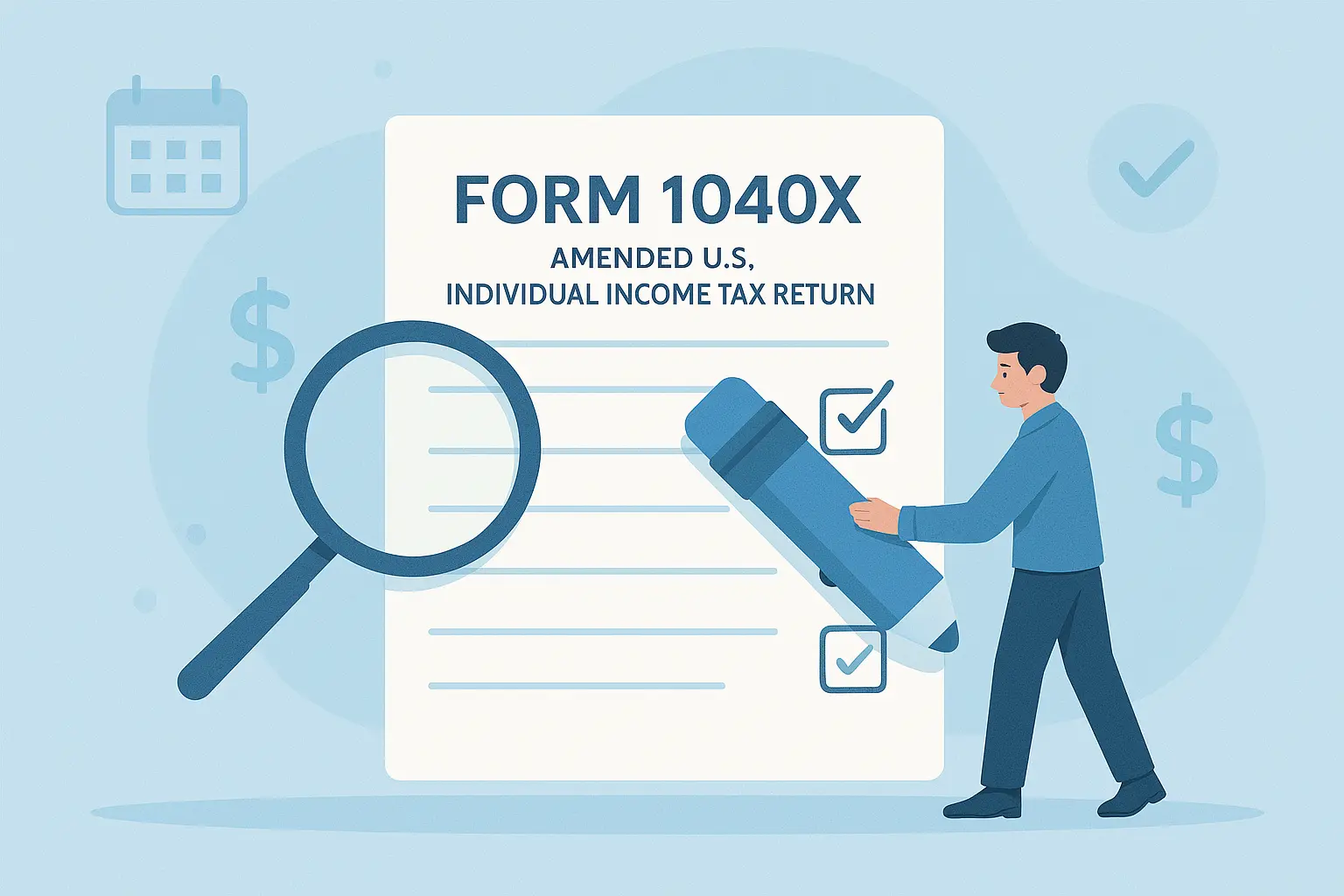
Filing tax returns accurately is crucial for maintaining compliance with tax laws and avoiding unnecessary penalties. Despite the best efforts to ensure accuracy, mistakes can occur, whether due to oversight, incorrect information, or changes in tax laws. If you discover an error in your previously filed tax return, it’s essential to correct it by filing an amended return using Form 1040X.
The importance of amending a tax return cannot be overstated. Not only does it help maintain compliance with the IRS, but it also prevents potential penalties and interest that can accumulate on unpaid taxes or incorrect deductions. Filing an amended return is a proactive step that demonstrates your commitment to tax compliance and can help resolve discrepancies before they become more serious issues.
By amending your tax return, you can correct errors, claim missed deductions, or report additional income that was not included in your original filing. This process ensures that your tax obligations are accurately reflected, which is vital for maintaining a clean tax record and avoiding audits or other complications with the IRS.
What is Form 1040X?
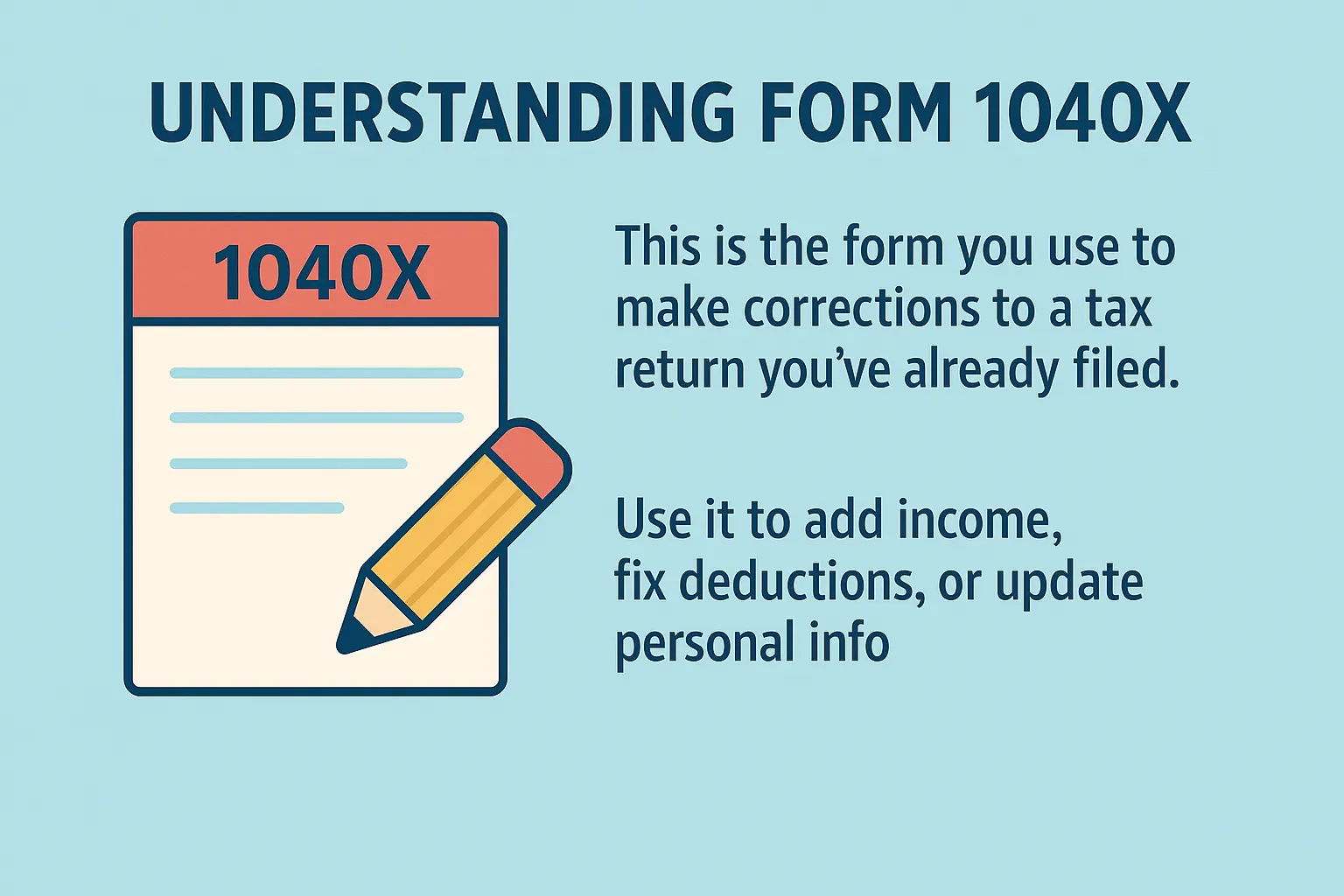
Form 1040X, also known as the Amended U.S. Individual Income Tax Return, is a form used by taxpayers to correct errors or make changes to a previously filed tax return. The purpose of this form is to allow individuals to update their tax information if they have made mistakes, missed deductions or credits, or need to report additional income that was not included in their original return.
Difference Between a Corrected and Amended Return

A corrected return typically refers to minor adjustments, such as mathematical errors, which the IRS often corrects automatically during processing. On the other hand, an amended return involves more significant changes, such as correcting filing status, adding dependents, or claiming missed deductions and credits, which require the taxpayer to actively file Form 1040X.
Common Situations for Amending
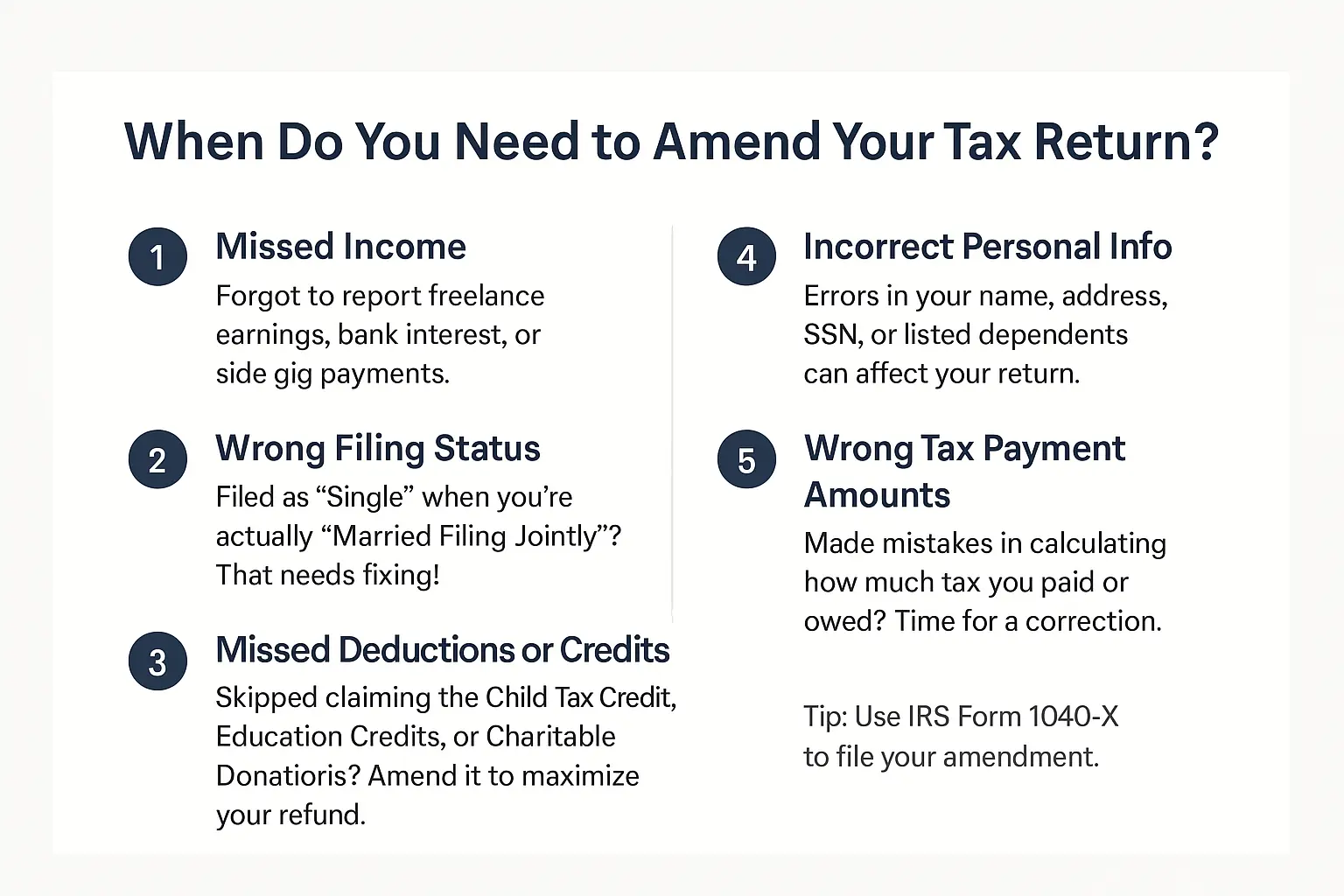
You might need to amend your tax return in several common situations:
- Missed Income: If you forgot to include income from a side job or received a corrected W-2 or 1099 form after filing.
- Deductions and Credits: If you missed claiming deductions or credits that you are eligible for, or if you incorrectly claimed them.
- Filing Status Changes: If your marital status or number of dependents changed and you need to update your filing status.
- Additional Payments: If you made additional payments after filing your original return.
By filing Form 1040X, you can ensure that your tax obligations are accurately reflected, which is crucial for maintaining compliance with the IRS and avoiding potential penalties.
Reasons You Might Need to Amend Your Tax Return
There are several reasons why you might need to amend your tax return using Form 1040X. These reasons often involve correcting errors or omissions that could impact your tax liability or compliance with tax laws.
Missed Income
One common reason for amending a tax return is missed income. This can include income not reported or reported incorrectly, such as:
- Freelance Earnings: If you have income from freelance work that was not included in your original return.
- Interest Income: Forgetting to report interest from savings accounts or investments.
- Other Income: Any other income that was not reported, such as tips or bonuses.
Incorrect Filing Status
Mistakes in filing status can also necessitate an amendment. This includes claiming the wrong status, such as filing as single when you should have filed as married, or vice versa. This can significantly affect your tax rate and deductions.
Deductions and Credits
Deductions and credits are another area where mistakes can occur. Missing deductions or credits can increase your tax liability. Examples include:
- Child Tax Credit: Failing to claim the child tax credit if you are eligible.
- Education Credits: Missing out on credits for education expenses.
- Other Deductions: Overlooking deductions for charitable donations, mortgage interest, or medical expenses.
Math Errors
Simple math errors can also require an amendment. These are often straightforward to correct but can lead to discrepancies if not addressed.
Other Mistakes
Other common errors include:
- Incorrect Personal Information: Mistakes in your name, address, or Social Security number.
- Overlooked Dependents: Failing to claim dependents you are eligible for.
- Incorrect Tax Payments: Incorrectly reporting tax payments made throughout the year.
By identifying and correcting these errors, you can ensure that your tax return accurately reflects your financial situation and avoid potential penalties from the IRS.
When Can You Amend Your Tax Return?
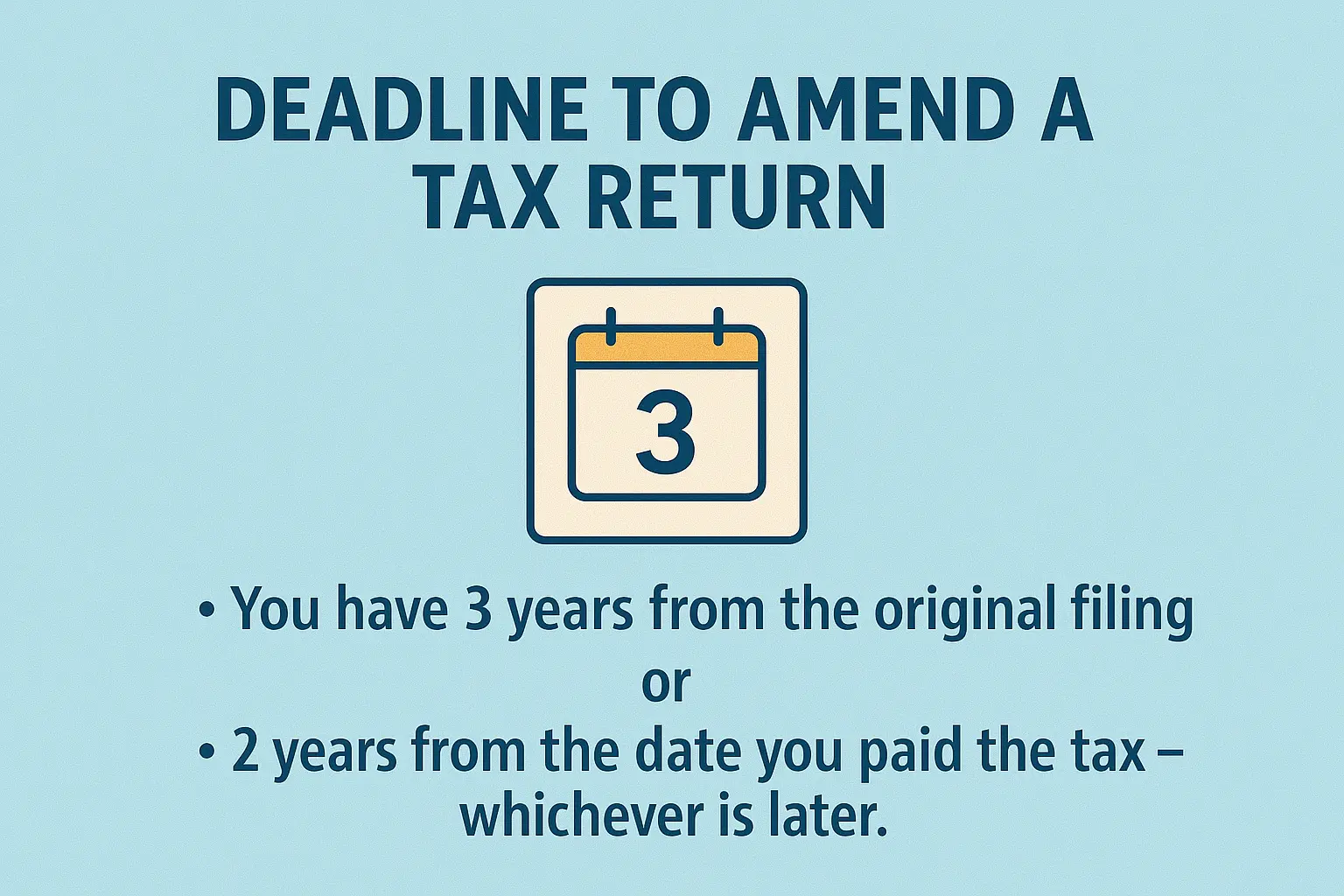
You can amend your tax return using Form 1040X within a specific timeframe set by the IRS. Generally, you have three years from the original filing date of your tax return or two years from the date you paid the tax, whichever is later, to file an amended return and claim a refund. This timeline is crucial for ensuring you receive any additional refund you are entitled to.
Impact on Refunds and Penalties
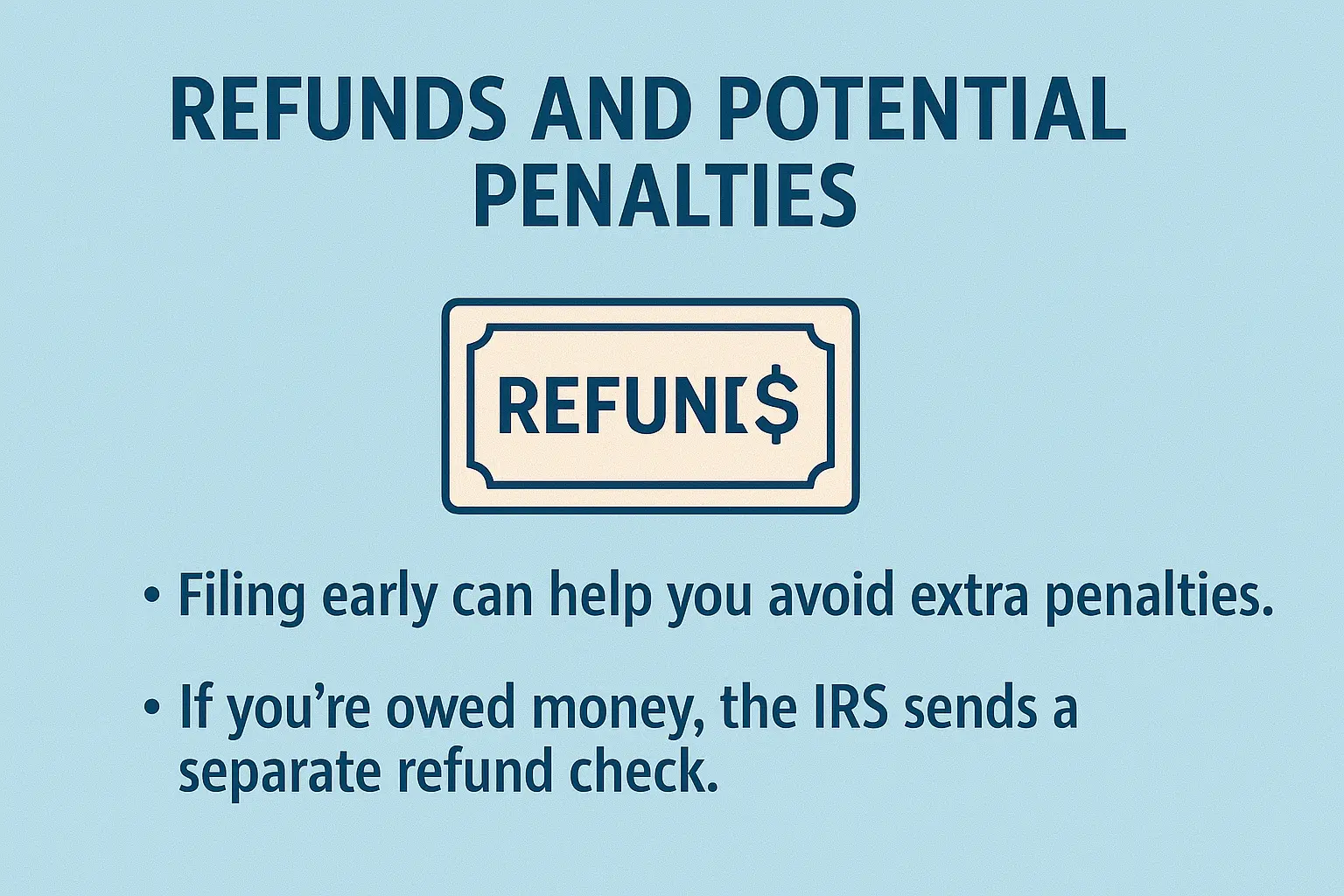
Filing an amended return within this timeframe can help you avoid penalties and interest on unpaid taxes. If you owe more taxes, filing an amended return before the IRS discovers the error can prevent additional penalties and interest from accumulating. However, if you are due a refund, the IRS will issue a separate refund check once the amended return is processed.
Situations Where Amendment May Not Be Necessary
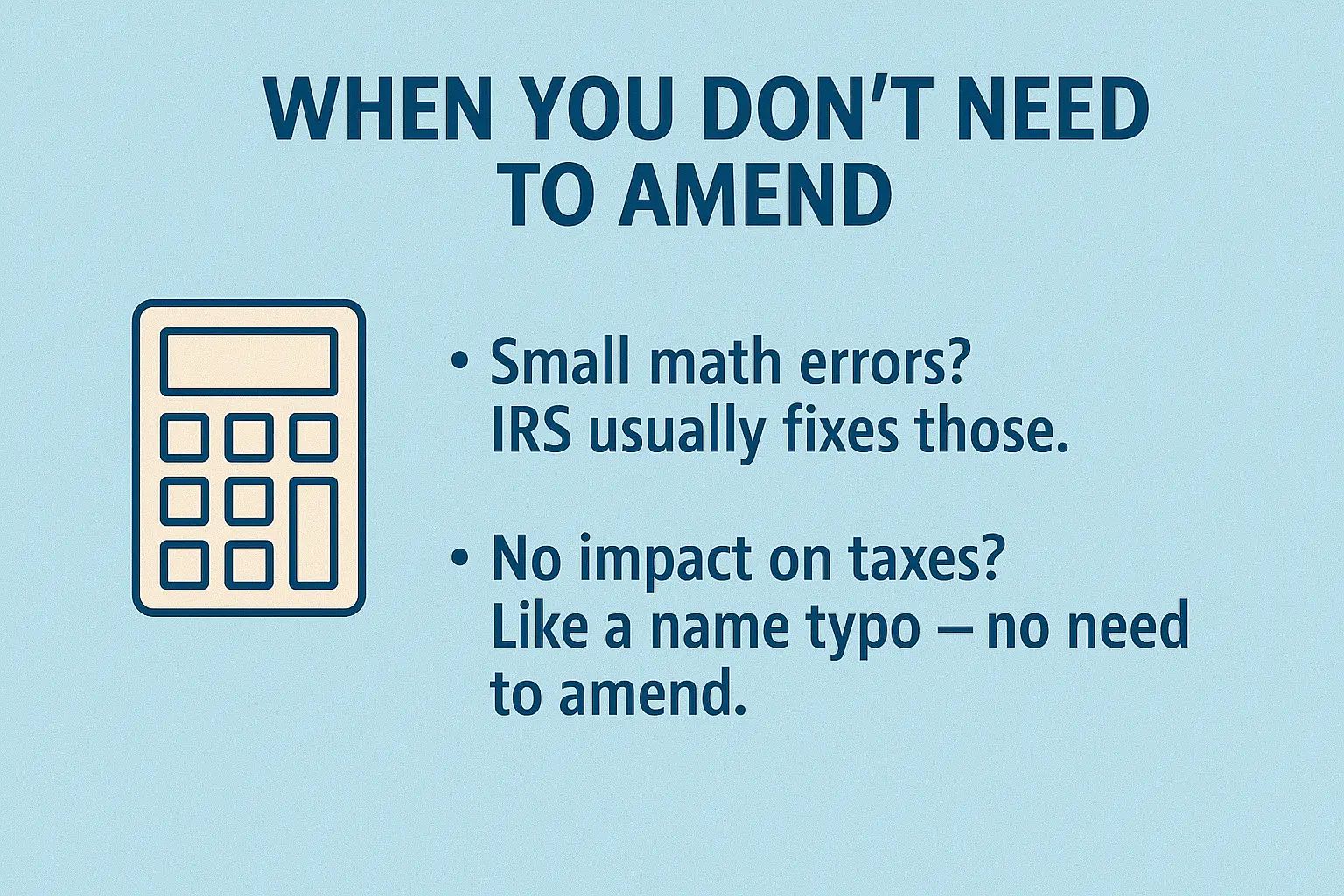
Not all errors require an amended return. For instance, minor math errors are typically corrected by the IRS automatically, and you will be notified of any adjustments. Additionally, if the error does not affect your tax liability, such as a simple clerical mistake that doesn’t change your tax amount, an amendment might not be necessary. However, if the error involves unreported income, incorrect deductions, or changes in filing status, filing an amended return is advisable to maintain compliance and avoid potential audits or penalties.
In cases where an audit is already underway, it’s generally recommended to inform the auditor about the mistake rather than filing an amended return during the audit process.
Steps to Amend Your Tax Return Using Form 1040X
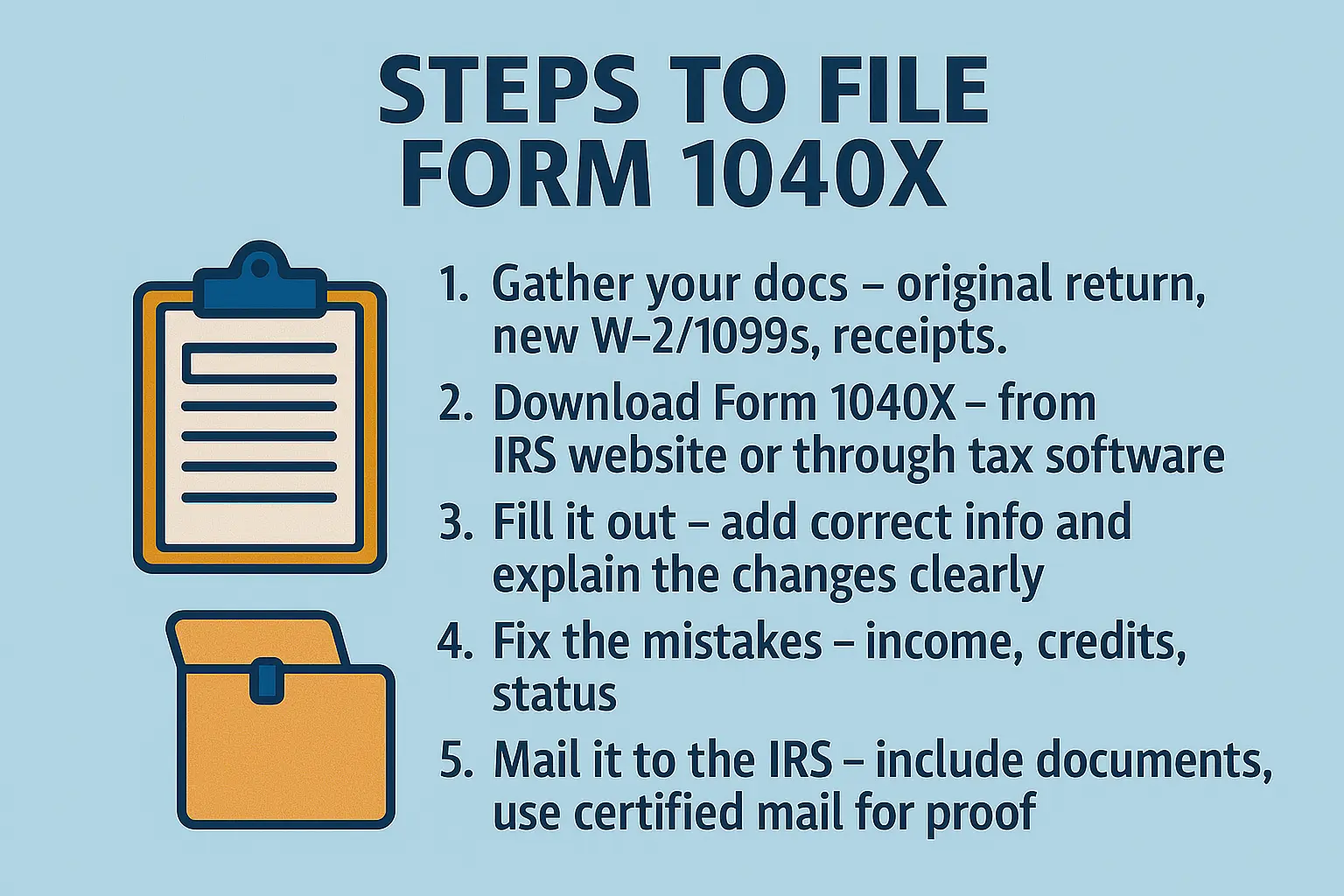
Amending your tax return involves several steps to ensure accuracy and compliance with the IRS. Here’s a step-by-step guide on how to use Form 1040X to correct errors or make changes to your previously filed tax return.
Step 1: Gather Required Documents
To begin the amendment process, you’ll need to gather several important documents:
- Original Form 1040: A copy of the tax return you are amending, including any supporting forms and schedules.
- W-2s and 1099s: Any new or corrected W-2 or 1099 forms that reflect changes in income or deductions.
- Corrected Documents: If you received corrected forms after filing your original return, ensure you have these documents.
- Supporting Documentation: Any receipts or records that support new deductions or credits you are claiming.
Having access to your original tax return is crucial for accurately completing Form 1040X.
Step 2: Obtain Form 1040X
You can obtain Form 1040X from the IRS website or through tax software that supports e-filing. The form is available in PDF format for manual filing or can be completed electronically using tax preparation software like TurboTax or H&R Block.
Step 3: Fill Out Form 1040X
Filling out Form 1040X requires attention to detail. Here’s how to complete it:
- Part I: Personal Information: Enter your name, address, Social Security number, and the tax year you are amending.
- Part II: Explanation of Changes: Clearly explain the reasons for amending your return. This could include correcting income, deductions, or filing status.
- Part III: Corrected Figures: Use the three columns to show the original amounts (Column A), the changes (Column B), and the corrected amounts (Column C).
Accuracy is crucial when filling out Form 1040X to ensure that your corrections are processed correctly.
Step 4: Correct the Mistakes
To correct mistakes, follow these steps:
- Income Corrections: If you missed income, such as freelance earnings or interest, add it to Column B of Form 1040X.
- Deductions and Credits: If you missed deductions or credits, enter the additional amounts in Column B.
- Filing Status Changes: Update your filing status if necessary.
- Refund or Payment: If your amended return results in a refund, the IRS will issue a separate check. If you owe more, you should pay the amount due to avoid additional penalties and interest.
Step 5: Mail the Amended Return
Once you’ve completed Form 1040X, mail it to the appropriate IRS service center based on your state of residence. Include any supporting documents, such as new W-2s or receipts for deductions. It’s recommended to mail the form via certified mail to ensure you have proof of delivery.
This step ensures that your amended return is processed correctly and that you maintain a record of submission.
Special Considerations When Amending a Tax Return
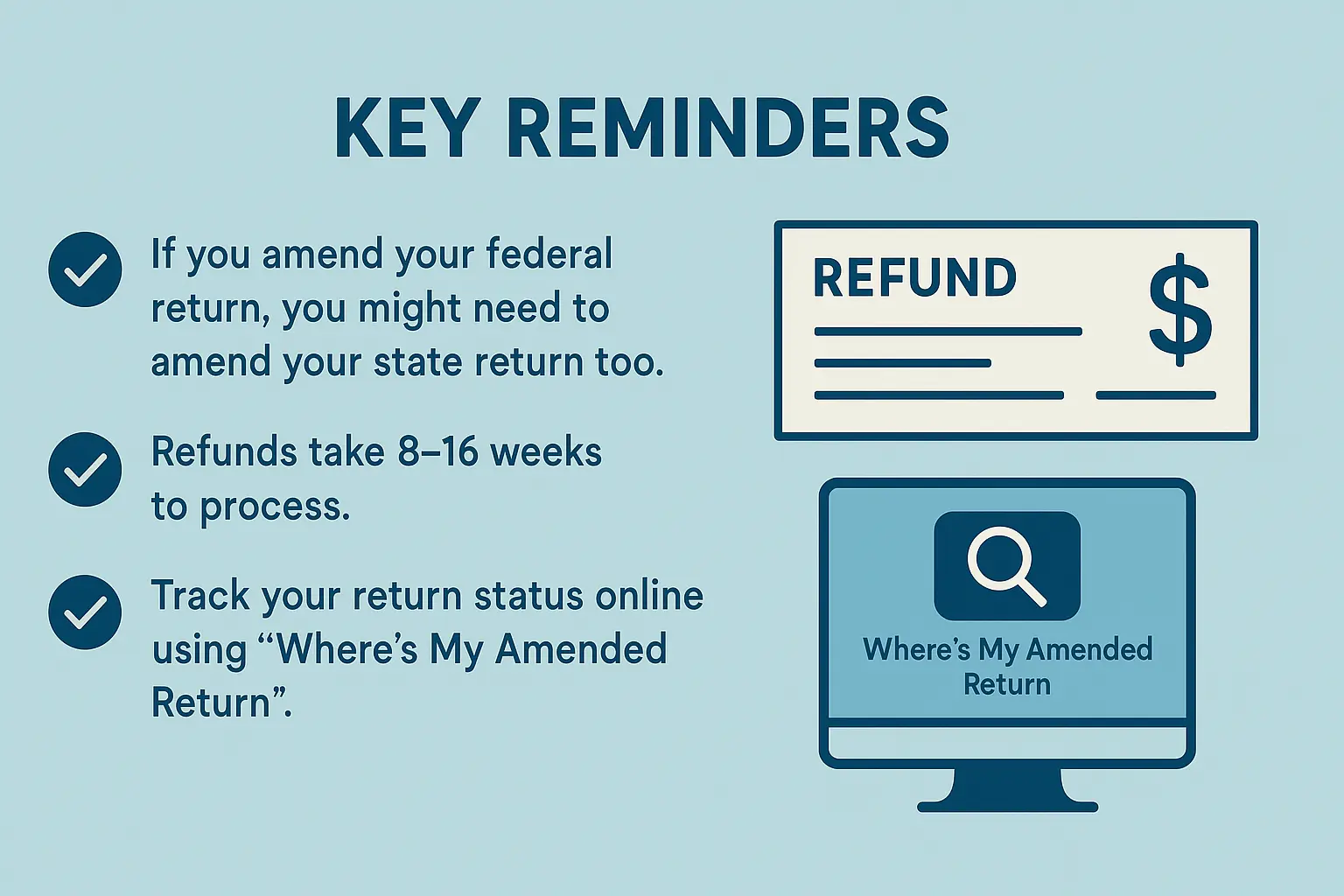
When amending a federal tax return, there are several special considerations to keep in mind to ensure compliance and avoid unnecessary complications.
State Taxes
If you amend your federal tax return, you may also need to amend your state tax return. Many states require taxpayers to file an amended state return if changes are made to the federal return. This is because state tax laws often mirror federal tax laws, and changes in federal income or deductions can affect state tax liability. It’s essential to check with your state’s tax authority to determine if an amended state return is required.
Refunds and Penalties
If your amended return results in a refund, the IRS will issue a separate refund check once the amendment is processed. However, if you owe additional taxes, it’s crucial to pay them promptly to avoid penalties and interest. The IRS charges penalties and interest on unpaid taxes, so timely payment is important to minimize these additional costs.
The IRS processes refunds for amended returns separately from the original return. If you are due a refund, you should wait for the IRS to issue a new refund check after processing your amended return.
IRS Processing Times
The IRS typically takes 8 to 12 weeks to process an amended return, but in some cases, it can take up to 16 weeks or more. You can check the status of your amended return using the “Where’s My Amended Return” tool on the IRS website about three weeks after submission. Processing times can be longer if your return requires additional review or if you claim certain credits like the Earned Income Tax Credit (EITC).
It’s important to be patient and ensure that any owed taxes are paid promptly to avoid additional penalties and interest. If you are unsure about any part of the process, consulting a tax professional can provide clarity and help ensure compliance with both federal and state tax laws.
Common Mistakes to Avoid When Amending Your Tax Return
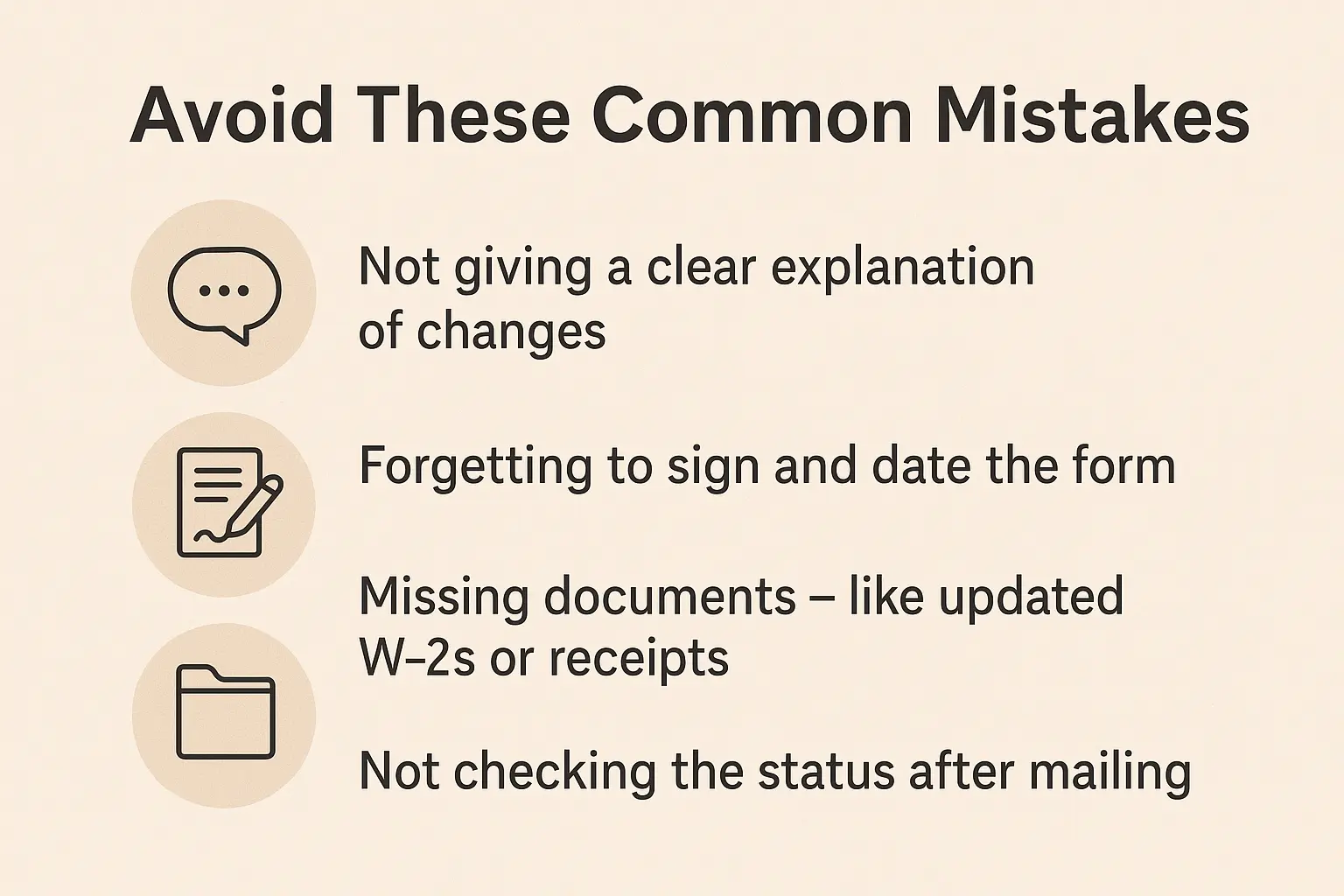
When amending your tax return using Form 1040X, it’s crucial to avoid common mistakes that can delay processing or lead to additional issues with the IRS. Here are some key errors to watch out for:
Not Providing a Clear Explanation of Changes
Filling out Part II of Form 1040X clearly is essential. This section requires a detailed explanation of the changes you are making to your return. Clearly stating the reasons for the amendment helps the IRS understand and process your changes more efficiently. Avoid vague explanations, and ensure that you provide enough detail to justify the corrections.
Forgetting to Sign and Date the Form
Signing and dating Form 1040X is a critical step. An unsigned or undated form will be rejected by the IRS, causing unnecessary delays. Make sure to sign and date the form before submitting it to ensure that it is considered valid.
Missing Documentation
Do not skip attaching necessary documents or forms to your amended return. This includes new W-2s, 1099s, receipts for deductions, or any other supporting documentation that justifies the changes you are making. Missing documentation can lead to delays or even rejection of your amended return.
Not Following Up
After submitting your amended return, it’s important to check its status. The IRS provides an online tool called “Where’s My Amended Return” that allows you to track the progress of your amended return. This helps ensure that your return is being processed and can alert you to any issues that need attention. Regularly checking the status can help you address any problems promptly and avoid further delays.
Frequently Asked Questions (FAQ)
Here are some common questions and answers about amending a tax return:
Can I Amend My Return Electronically?
Yes, you can amend your tax return electronically for certain tax years and situations. The IRS allows e-filing of Form 1040X for tax years 2019 and later if you originally filed electronically. However, not all tax software supports e-filing amended returns, so it’s important to check with your provider.
What Happens if I Don’t Amend My Tax Return?
If you don’t amend your tax return and there are errors or omissions, you may face penalties and interest on unpaid taxes. Additionally, you could miss out on refunds or credits you are eligible for. The IRS may also initiate an audit if discrepancies are detected.
Can I Amend a Tax Return After the Deadline?
The deadline to amend a tax return is generally three years from the original filing date or two years from the date you paid the tax, whichever is later. If you miss this deadline, you cannot amend your return for a refund, but you can still file an amended return if you owe taxes to avoid further penalties.
How Will I Know if the IRS Accepts My Amended Return?
You can track the status of your amended return using the IRS’s “Where’s My Amended Return?” tool. This tool allows you to check if your return has been received and processed.
What if I Need to Amend a Return for a Prior Year?
You can amend a return for a prior year as long as it’s within the three-year window from the original filing date or two years from the date you paid the tax. You’ll need to file a separate Form 1040X for each year you are amending.
Is There a Fee to Amend My Tax Return?
There is no fee charged by the IRS to file an amended return. However, if you use a tax professional or software to assist with the amendment, you may incur costs ranging from $200 to $1,500, depending on the complexity of the changes.
Conclusion
Amending your tax return using Form 1040X is a straightforward process that involves gathering necessary documents, obtaining the form, filling it out accurately, correcting mistakes, and submitting it to the IRS. This process is crucial for correcting errors or omissions in your original return, which can help avoid penalties and ensure accurate tax filings. By amending your return, you can claim missed deductions, report additional income, or correct filing status errors, all of which are essential for maintaining compliance with tax laws.
Correcting errors promptly is vital to prevent unnecessary penalties and interest from accumulating. If you are unsure about any step of the process, it’s advisable to seek help from a tax professional. They can guide you through the amendment process, ensuring that your return is accurate and complete, which can provide peace of mind and protect you from potential audits or complications with the IRS. By taking proactive steps to correct mistakes, you can ensure that your tax record remains clean and up-to-date.
